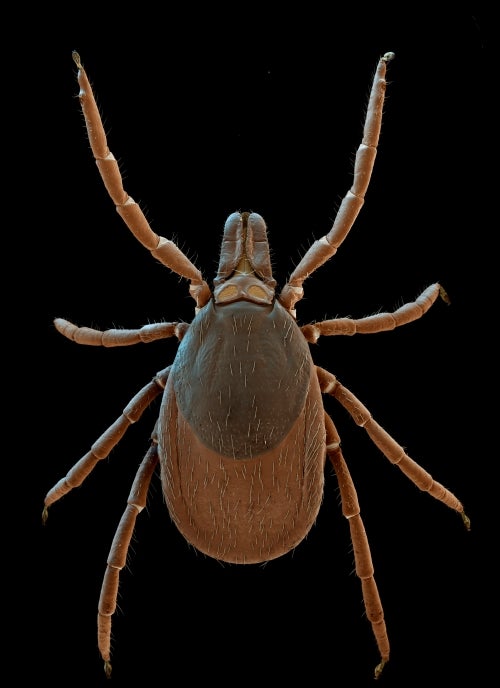GENERAL
Ticks are important blood-feeding external parasites of mammals, birds and reptiles throughout the world, with however very different species of relevance regionally.
All stages of the tick developmental cycle (larva, nymph and adult) are parasitic on vertebrates.
It is suggested that both ixodid and argasid ticks have been in existence since the late Paleozoic to early Mesozoic eras (Hoogstraal and Kim, 1985).

Adult female Ixodes ricinus
Taxonomy
Hard Ticks
Soft Ticks
Distribution
References
Further Reading
TAXONOMY
Ticks are members of the same phylum (Arthropoda) of the animal kingdom as insects, however they are in a different class.
The subphylum Chelicerata includes the class Arachnida, which again contains several subclasses. The subclass Acari (syn. Acaria, Acarina, Acarida) includes ticks.
A characteristic of the Acarines is the extreme fusion of body segments, in contrast to the known three body segments head, thorax and abdomen in insects.
Taxonomy of ticks
| Kingdom: | Animalia |
| Phylum: | Arthropoda |
| Class: | Arachnida |
| Subclass: | Acaria (Acari, Acarina, Acarida) |
| Order: | Anactinotrichidea (= Parasitoformes) |
| Suborder: | Ixodida (= Metastigmata) |
| Family | Ixodidae (Hard Ticks) Argasidae (Soft Ticks) |
The Acari are subdivided into the order Parasitiformes and Acariformes.
The order Parasitiformes to which ticks belong have stigmatal pores on the podosoma part (leg-bearing portion) and free articulated coxae (Sonenshine, 1991).
Their suborder is Metastigmata, as their stigmen can be found behind coxa III or behind coxa IV. Its members are obligate blood-sucking parasites which have the following common features:
- Haller's organ - a complex sensory organ, on tarsus I
- Ventral toothed hypostome
- Chelicera of only two joints
- Peritreme around the stigmen
The order Metastigmata comprises three families: the Ixodidae (hard ticks), the Argasidae (soft ticks), and the Nuttalliellidae.
The Nuttalliellidae are represented only by a single species, Nutalliella namaqua; found in South and South-West Africa as a parasite of small mammals. Thus, the two tick families of relevance are Ixodidae (hard ticks) and Argasidae (soft ticks) (Pfister, 2006; Sonenshine, 1991).
The accurate identification of tick species is an important factor in the detection and diagnosis of tick-borne diseases and is a prerequisite for tick control (Cupp, 1991).
EXPLORE OUR CONTENT
 CVBD MapsThe CVBD Occurence World Map presents country-specific situations based on current scientific knowledge and feed-back from experts around the world in an easy-to-grasped way. |
| Read more-> |
 ResourcesElanco Animal Health supports education in parasitology and especially in the field of vector-borne diseases. Access image collections, discover the World Forum calendar, interesting links and our glossary. |
| Read more-> |
 CVBD World ForumThe CVBD World Forum is a working group of leading international experts with the mission to enhance knowledge and communication on companion animal vector-borne diseases for the improvement of animal, human, and environmental health. |
| Read more-> |
